A Blog for Dallas Area Catholics November 4, 2011 Posted by tantamergo
Most people have at least some small familiarity with the mighty McDonnell Douglas (now Boeing)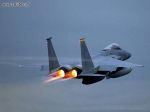 F-15
Eagle. First entering service in 1974, the Eagle has been the mainstay
US air superiority aircraft for 40 years (uhhh….which isn’t exactly
good that it’s been that long – can you imagine Wright Flyers fighting
WWII?). It’s a beautiful ship. It has an unparalleled air to air
combat record – over 100 kills and zero losses (although, the quality
of the opposition does sort of diminish that record). But what everyone
knows as the F-15 could have been a radically different, and in some
ways even more capable, aircraft, had things gone a bit differently.
F-15
Eagle. First entering service in 1974, the Eagle has been the mainstay
US air superiority aircraft for 40 years (uhhh….which isn’t exactly
good that it’s been that long – can you imagine Wright Flyers fighting
WWII?). It’s a beautiful ship. It has an unparalleled air to air
combat record – over 100 kills and zero losses (although, the quality
of the opposition does sort of diminish that record). But what everyone
knows as the F-15 could have been a radically different, and in some
ways even more capable, aircraft, had things gone a bit differently.The military, in particular, almost never produces a weapon system without a competition within private industry to try to find the very best product available. The competition that produced the F-15 was started in the late 60′s and was known as Fighter-Experimental (F-X). The F-X competition had developed in fits and starts over the last half of the 60s, with the USAF originally wanting a Mach 2.7-3 superinterceptor+ ground attack aircraft – sort of an ultimate F-4. But the disastrous performance of US aircraft in air combat in Vietnam made the USAF reconsider and reposition the F-X competition for an all out air supremacy aircraft. There were 3 main contenders in the latter stages of F-X – Fairchild Republic, McDonnell Douglas, and North American Aviation, Inc. We all know the McDonnell plane already, and the Republic plane didn’t really have a chance, but the North American plane almost won the competition, and some say should have.
Throughout the 1950s, North American had frequently been the #1 defense contractor. But in the 60s, the company had a number of huge projects cancelled and even with their huge role in the Apollo program had fallen on somewhat hard times. They needed to win this competition for the USAFs next generation mainstay fighter. They pulled out the stops.
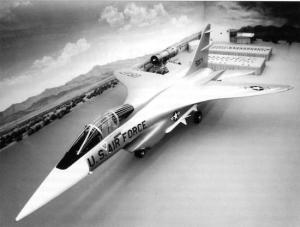
There is no question the NA-335 as it was known was aerodynamically far advanced on the F-15, possessing features that would not be seen on other aircraft for another 5-8 years (which, back then, was a very long time in aviation years). It had wings blended into the fuselage, a box intake, and the wings had a graceful, curving design. Horizontal stability may have been a bit of an issue without twin vertical tails, but the rest of the aircraft looked a winner. The avionics package was very advanced for its time – even more advanced than McDonnell’s (and it is avionics – aviation electronics – that have provided the true edge for US aircraft since Vietnam and precipitated their dominance). But it was expensive.
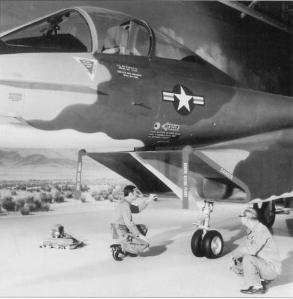
In today’s eras of trillion dollar deficits and military tactical aircraft with unit flyaway costs on the order to $100 million it’s amazing that a competition like the F-X would be decided on an expected cost differential of $200 million, but that was really the issue. North American’s proposal involved the construction of a new manufacturing plant, and the cost of that, plus the more complex avionics suite, caused the North American proposal to have expected lifetime program costs $200 million more than McDonnell’s. There was also a comfort factor – McDonnell’s design had derived from NASA studies that had been extensively wind tunnel tested, and the Air Force may have had more confidence in the aerodynamic qualities of the McDonnell design. Sadly, at that time, the USAF did not conduct fly-off competitions between aircraft and judged the merits on the paper designs – some aviation historians feel that if a flyoff had been held, the North American design would have emerged the clear winner.
Today, almost no one remembers this aviation also ran. There are almost no pics of it on the web, although I have a book at home with some very nice artwork and 3-views. I’ve posted the only photos I can find:
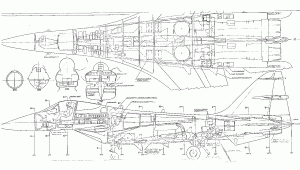
North American was bought by Rockwell International during the F-X competition. Although North American Rockwell went on to produce the B-1 bomber and some test aircraft, the company gradually drifted more and more behind the times. For the USAF’s next heavyweight fighter competition, the Advanced Tactical Fighter, their design finished last. It was aerodynamically quite up with the times, but completely behind the times in terms of stealth technology. North American Rockwell was absorbed by Boeing in the 90s and no longer exists.
UPDATED: Well shuck my corn, I just found 2 gorgeous prints of the North American model NA 335, the F-15 competitor:
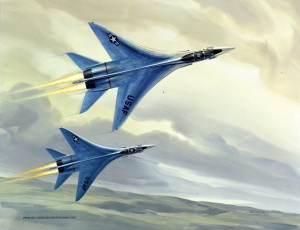
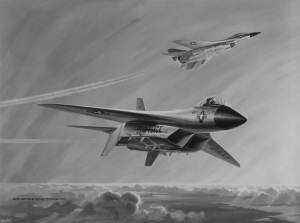
It was said that the designer of the Sukhoi Su-27, the F-15′s Russian competition, was glad that USAF chose the McDonnell design over the North American one, because he felt he could design a superior aircraft relative to the McDonnell design, but not the North American one. He did, at least aerodynamically. In fact, the Su-27 appears to borrow a fair amount from the NA-335.
And, I retract what I said about horizontal stability, until I found that print on the bottom, I’d never seen those ventral stabilizers. Beautiful ship.
No comments:
Post a Comment